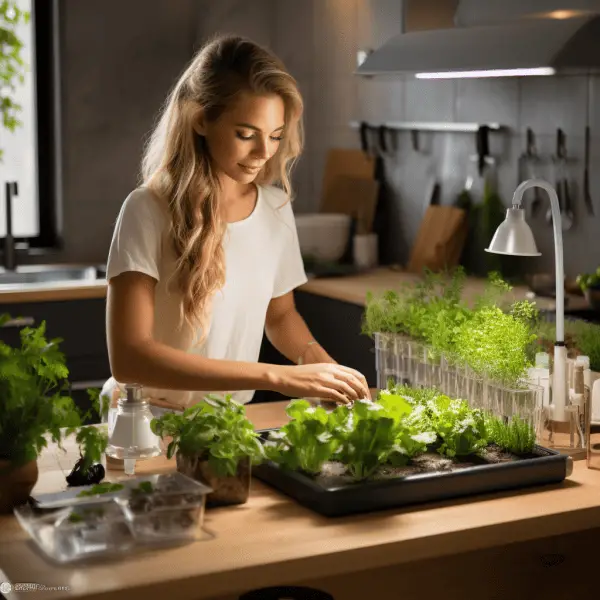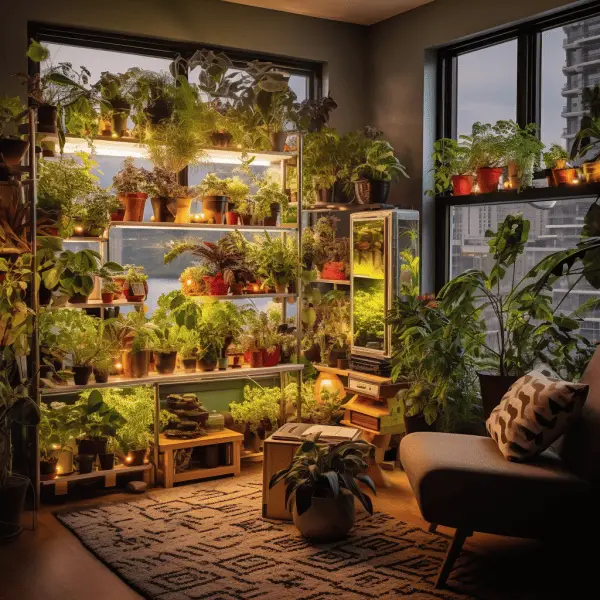Hydroponics can transform even the smallest apartment into an indoor veggie garden.
Growing plants without soil practically guarantees bountiful harvests.
But with so many kits on the market, picking the right hydro system for your needs gets tricky.
I learned the hard way after purchasing kits that didn’t suit my space or gardening experience.
Don’t waste money on unusable equipment.
This guide breaks down the key factors to consider when shopping for home hydroponic kits.
Discover which features and functions matter most before investing in these game changing but complex gadgets.
Find the perfect hydroponic kit for your growing ambitions and space constraints.
You’ll gain the knowledge needed to cultivate mouthwatering tomatoes and crisp greens even if you’ve never gardened before.
Hydroponics puts produce potential at your fingertips if you choose wisely from the start.
KEY TAKEAWAY
How to choose a home hydroponic kit?
Consider plant needs, available space, and your experience level to choose the right home hydroponic kit for successful indoor gardening.
Evaluate different hydroponic system types, assess their advantages and drawbacks, and match them with your gardening preferences to select the ideal kit for your home.
Understanding Hydroponic Systems
Hydroponics allows growing plants without soil by supplying nutrients through water.
The roots suspend in an oxygenated, mineral-rich solution that fuels rapid growth.
Hydroponic systems provide the perfect conditions for uptake of water and nutrients on demand.
Grow lights like LEDs simulate full-spectrum sunlight for indoor crops.
With control over the root zone environment, hydroponics grows plants faster and with higher yields than soil.
But this soilless gardening does require closer monitoring of pH, nutrients, and equipment.
Home hydroponic kits make the technology more accessible.
But finding the right system takes some research. (1)
This guide will explore the most popular options to help you pick the best hydroponic method and equipment.
Exploring Hydroponic System Varieties

Many different hydroponic system designs exist. The most common types used in home kits include (2):
- Deep Water Culture – Plants sit in containers of oxygenated nutrient solution. Air pumps provide constant aeration.
- Drip System – Nutrient solution drips onto roots suspended in grow media like perlite. Automated drippers prevent overwatering.
- Ebb and Flow – Plants flood with nutrients then drain repetitively. The cycling flows oxygenate roots.
- Wicking Beds – Absorbent grow media wicks solution upward to roots. Less complicated for beginners.
- Nutrient Film Technique – A thin film of nutrients constantly flows through suspended roots. Requires careful flow monitoring.
Each hydroponic method has pros and cons. Consider plant types, space, cost, and technical skills when choosing systems. Kits simplify setup but limit customization.
Evaluating Home Hydroponic Kits
Pre-designed hydroponic kits bundle all the components into a ready-to-grow package.
They come in many configurations for different spaces and budgets.
Consider these factors when choosing home hydroponic systems:
- Size – Measure your space for the reservoir and grow area. Multi-level kits maximize footprint.
- Plant capacity – More pods allow larger harvests but occupy more space. Choose based on your planting goals.
- Lighting – Full-spectrum LEDs are ideal for indoor use. Upgrade wattage for fruiting plants.
- System type – Look for hardy beginner-friendly methods like wicking beds or deep water.
- Automation – Timers, pumps, and sensors reduce maintenance once set up.
- Materials – Plastic is affordable but less durable than stainless steel.
- Cost – Simple starter kits run $50-200. Advanced systems cost $500+.
There are kits for all needs and experience levels. Write down must-have features before shopping to find the best hydroponic system for your gardening.
Expert Hydroponic Kit Reviews
Reading customer reviews helps identify the top-performing hydroponic kits worth considering.
Here are some current highly-rated options:
- AeroGarden – Compact and stylish counter-top gardens for herbs and greens.
- Lettuce Grow – Larger in-home and outdoor modular metal systems expandable to 200+ plants.
- Rise Gardens – Attractive wooden tower kits take up little space with multi-level designs.
- iDOO – Budget-friendly plastic indoor gardens with handy app controls for monitoring.
- Hydrofarm – Broad range of quality components to customize large-scale systems.
- Green Haus – Reliable starter kits made in the USA for salad greens and herbs.
Expert and buyer reviews help narrow the options.
Focus on systems best suited for your planned crops, space, and technical expertise.
Selecting the Right Hydroponic System
With so many kits and components available, choosing the right hydroponic system involves careful consideration.
Start by deciding on the plants you want to grow – leafy greens and herbs thrive in most setups, while tomatoes and cucumbers require higher lighting and capacity.
Next, measure your physical space for the reservoir and grow area placement.
Compact countertop units like AeroGarden work well for small urban apartments.
For bigger harvests, vertical designs like Rise Gardens maximize yield in limited footprints.
Also factor in your level of experience – if new to hydroponics, choose forgiving systems like wicking beds or deep water culture.
More advanced techniques like NFT require diligent monitoring to avoid problems.
Finally, decide on your budget limitations.
Quality entry-level systems range from $100 to $300 while commercial-scale setups can cost thousands.
Review kit specs and determine must-have features that best suit your needs.
Taking the time to properly evaluate your hydroponic gardening goals, space constraints, and technical skills will ensure you select the right system for success.
Tips for Effective Hydroponic Gardening
Hydroponic kits simplify the setup, but effective ongoing maintenance is vital.
Here are some tips for keeping your system in optimum health:
Start with quality seeds and nutrient solutions designed for hydroponics.
- Maintain optimal temperature and humidity levels in your grow space.
- Keep close tabs on pH and nutrient levels in the reservoirs.
- Clean pump intakes and lines regularly to avoid clogging.
- Check for leaks and loose fittings often.
- Sterilize equipment and reservoirs between plantings to prevent disease.
- Prune and transplant plants for even growth and spacing.
- Invest in upgrades like circulation fans as your system expands.
- UV filters also help control algae and bacteria.
Following best practices reduces headaches and maximizes your hydroponic harvests.
Consistent monitoring and maintenance gives your plants the ideal soilless environment to thrive.
Comparing Indoor Garden Options
Hydroponics offers many benefits over traditional soil gardening, but it’s not the only method for indoor growing.
How do hydroponic systems compare to other indoor gardening options?
Hydroponics provides the fastest growth rates by optimizing nutrients, lighting, and humidity.
Direct access to water and minerals surpasses the limits of container gardening.
However, hydro does require more frequent monitoring than soil.
Aeroponic systems mist roots suspended in air for maximum oxygen.
But the fine misters clog easily, increasing maintenance.
Passive wicking beds pump-free designs can be more forgiving.
Small countertop greenhouses like Click and Grow use proprietary grow pads.
While simple, plant variety and yields are restricted.
Expandable indoor hydro systems have far more capacity.
When it comes to indoor gardening, hydroponics delivers the highest productivity per square foot.
Its focus on root zone conditions maximizes plant health and fruiting.
The trade-off is increased system complexity.
Take time to learn the techniques for success.
Hydroponic System FAQs
Switching from traditional gardening to hydroponics brings many new questions for beginners.
Here are answers to some frequently asked questions:
What plants grow best hydroponically?
Leafy greens like lettuce, spinach, kale, along with herbs like basil, mint, and parsley thrive with hydroponics.
Fruiting vegetables like tomatoes, peppers, cucumbers, and berries also produce well in proper systems.
How often do I need to monitor the reservoir?
Check and adjust the pH and nutrient levels at least every 7-10 days.
More frequent monitoring is needed in smaller reservoirs or for seedlings.
Test strips make readings quick and easy.
Can I begin without expensive grow lights?
Some plants may grow using just natural sunlight, but variety and yield will be very limited unless you have very bright southern facing windows.
Quality full spectrum LED grow lights are essential for robust indoor harvests year-round.
What maintenance is required?
Regular maintenance like cleaning pumps and lines prevents problems.
Change reservoir water every 2 weeks to stop algae and bacteria.
Prune and transplant plants for optimal health and spacing.
Calibrate pH meters and monitor all equipment function.
Is hydroponic produce organic?
Hydroponic produce can be grown using only approved organic nutrients in the reservoirs.
However, without soil it cannot be USDA certified organic.
But produce is not subject to same soil-borne pests and chemicals.
How do I choose the best hydroponic system?
Factor in your space, budget, plant choices, and technical expertise.
Simpler kits are great for first-timers to get started.
Consider upgrade potential as your skills improve over time.
What common problems will I encounter?
Nutrient balance, pH fluctuations, algae growth, and pump malfunctions are common challenges.
Take time to learn how to avoid and address issues that come up with your particular system.
Don’t hesitate to ask experienced growers for advice.
Doing proper research upfront prepares you to tackle the unique requirements of soilless gardening.
Don’t hesitate to reach out to hydroponic communities for advice as you learn the ropes!
Conclusion
The world of hydroponic kits holds boundless opportunities for indoor growing.
But the diversity of systems and capabilities make choosing overwhelming.
Focus on your personal goals, space, and budget when evaluating options.
Seek kits with room to expand as your skills progress.
Automatic controls reduce maintenance once you master nutrient management.
And don’t forget lighting – LEDs fuel lush indoor harvests.
With the right hydroponic kit, anyone can unlock a bounty of fresh veggies without access to outdoor space.
Now that you know what to look for, you can confidently join the soilless gardening revolution.
Try a starter hydroponic system and taste the amazing difference homegrown freshness brings to your table.
Then come back and share which fruits and veggies thrived best under your new LED sun.
References
- https://hydroponicway.com/how-to-choose-right-hydroponic-system/
- https://www.freshwatersystems.com/blogs/blog/what-are-hydroponic-systems
Related Articles
- https://tophydroponicgarden.com/top-5-home-hydroponic-kits/
- https://tophydroponicgarden.com/home-hydroponic-kits/
- https://tophydroponicgarden.com/hydroponic-kits/
Was this helpful?

Crystal Erickson is an agriculture enthusiast and writer with a passion for sustainable farming practices and community development. Growing up on a family farm in rural Iowa, Crystal developed a love for the land and a deep appreciation for the hard work and dedication required to make a farm successful.
After completing a degree in Agriculture and Environmental Science from Iowa State University, Crystal began her career as an agricultural journalist, covering stories and issues related to modern farming practices, crop management, and livestock production. She quickly established herself as a respected voice in the industry, known for her insightful reporting and thoughtful analysis.
Over the years, Crystal has written for a variety of publications, including Farm Journal, Successful Farming, and Modern Farmer, as well as contributing to several academic journals focused on sustainable agriculture and community development. Her work has been recognized with numerous awards, including the Iowa Farm Bureau’s Young Farmer Achievement Award and the National Association of Farm Broadcasting’s Farm Broadcaster of the Year.


